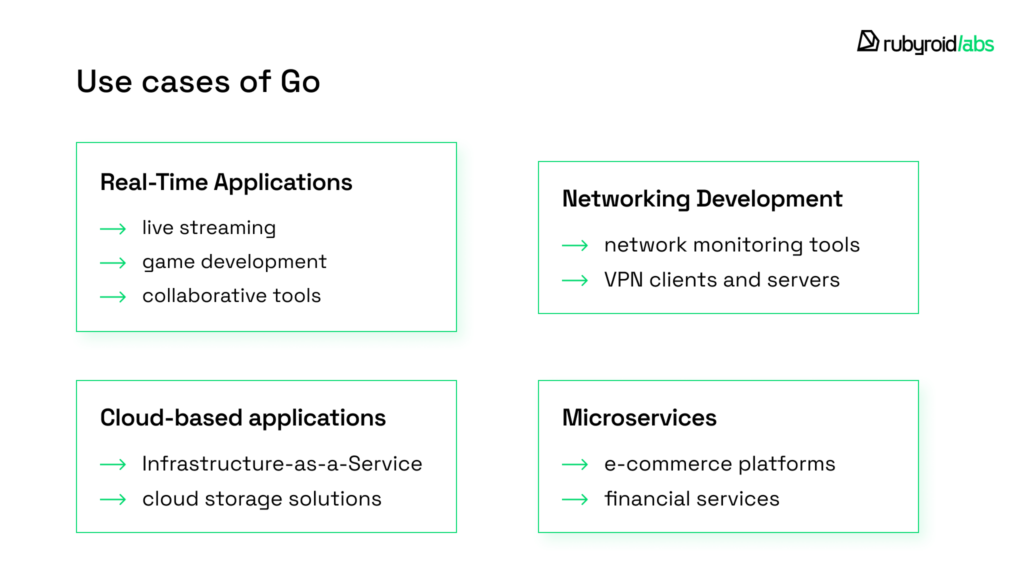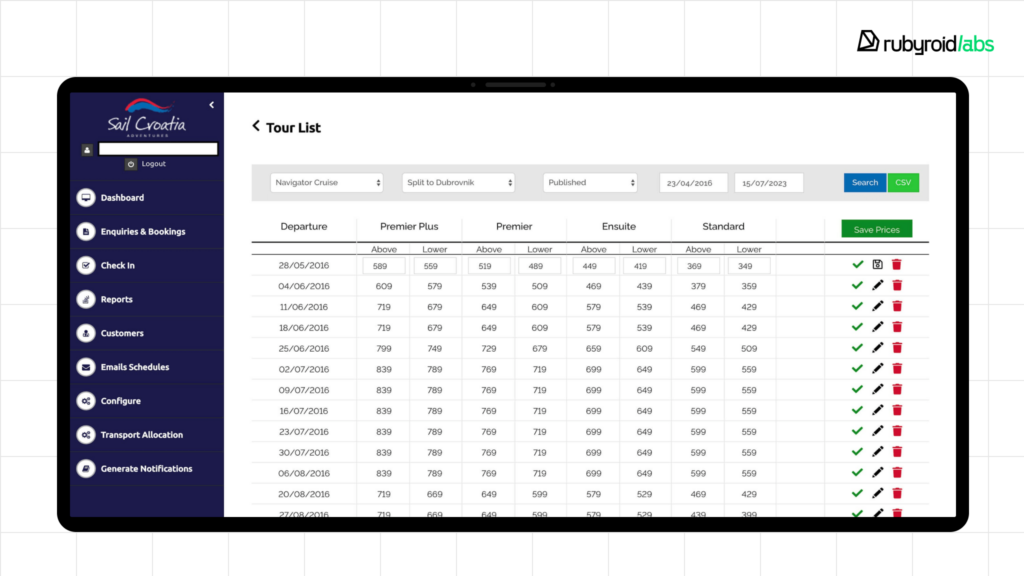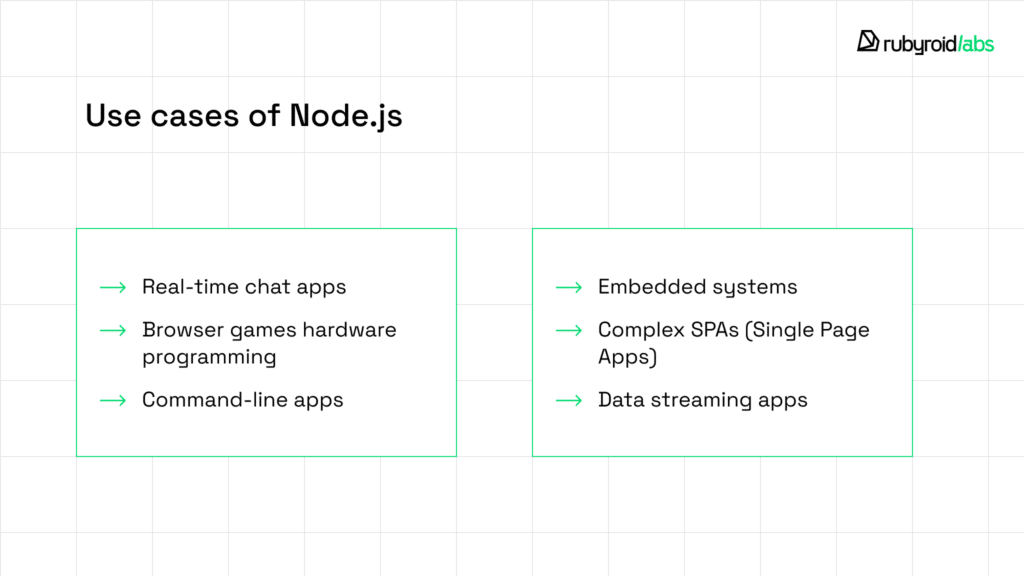Nodejs vs Golang. Deciding on a technology for a prospective project might be sometimes confusing. Both paths look equally appealing, yet they take you to really different destinations.
Whether you’re setting up a cloud solution, making a messaging application, or building microservices, you need tech that hits the sweet spot — fast to develop, performs well, and won’t be a pain to maintain later on.
With this post, we at Rubyroid Labs help you see what sets Go and Node.js apart. You’ll get a clear picture of each technology and learn whether they match with your project’s goals and needs.
If you’re looking for a professional development team to build your application from scratch or rebuild the existing one, get in touch with us.
Our engineers have experience across a variety of industries, including automotive, e-commerce, healthcare, insurance, finance, and sports. We’ll walk you through the best tech choices for your backend, plus give you a full breakdown of what your application will need.
Contents
- Node.js vs Golang: Key Characteristics and Differences
- A Deep Comparison of Go vs Node.js’s key features
- Advantages and Disadvantages of Golang
- Pros and Cons of Node.js
- Use Cases of Go and Node.js
- Conclusion
Node.js vs Golang: Key Characteristics and Differences
Go and Nodejs are heavy hitters in backend development, each with its own philosophy and purpose.
Go was made by Google to tackle current computing challenges, while Nodejs has turned JavaScript from a simple browser language to a full-stack powerhouse.
Let’s see what makes these two technologies so special.
What’s Node.js?
Node.js is an open-source runtime built on Chrome’s V8 JavaScript engine, letting JS developers use the same language for both the frontend and backend of an application.
Now, if we’re talking about performance, Nodejs is like a super-efficient office assistant who’s great at multitasking. It can handle tons of different requests — answering phone calls, responding to many emails, or filling out paperwork. Node.js does it all without breaking a sweat.
However, if there is something that takes brainpower, like solving a complex math problem or handling heavy computations, Nodejs might slow down. It’s smooth for simple, repetitive tasks, but for CPU-heavy tasks, it might struggle to keep up.
Key Characteristics of Node.js
These are the standout characteristics of Node.js that also reflect its philosophy:
- JavaScript-based: uses the same language as the frontend thanks to Chrome’s V8 engine.
- Component-based structure: code is split into small, useful pieces — like building with Lego. This makes it easy to fix, change, or add new features.
- Runs on a single thread: uses one main path to manage work but efficiently switches between tasks when one takes too lengthy. Like a chef preparing various dishes by switching between pots and pans.
- Rapid-scaling: can serve many users at once, making it great for apps that need instant responses, like chat programs.
- Ready-made tools — NPM (Node Package Manager): comes with a large library of pre-built tools and code parts that developers may utilize, similar to choosing from a giant toolbox.
- Cross-platform: works on any platform, such as macOS, Windows, or Linux.
What’s Golang?
Golang is a statically typed language made by Google. It’s super fast and to-the-point, which makes it perfect for cloud services and modern distributed systems.
If we stick with analogies, Go resembles a skilled project manager—both methodical and fast. It can break down complex tasks into smaller, manageable pieces, assigning them to a team. In Go’s case, that “team” consists of goroutines—lightweight, efficient workers that can handle multiple tasks in parallel. Moreover, Go doesn’t just focus on simple, repetitive tasks but also cracks big problems, optimizes workflows, and ensures that large, complex projects are completed efficiently and on time.
Just like Node, Go can handle simple tasks, but it goes further. It’s great at heavy lifting too, like analyzing complex data, running calculations, or building programs that can grow big over time.
Key Characteristics of Go
Now, we’ll pass to the Go’s core features that highlight its philosophy:
- Rapid to compile: translates the written code into machine code really fast so programmers can see the result almost immediately.
- High concurrency: provides the programs the ability to multitask through goroutines, which act like hundreds of workers communicating with each other through ‘walkie-talkies’ called channels.
- Ready-made testing tools: has the tools for testing, benchmarking, and documenting your code.
- Built-in library: has all the basic tools for common tasks, so you don’t need to download external packages.
- Static typing: catches mistakes early with strict type checking but still keeps the code easy to follow.
- Simplicity: produces clean code with minimal syntax, minimal fuss, and built-in formatting rules that make it easy for any developer to read.
- Memory management: manages memory consumption automatically and includes built-in garbage collection while still allowing for low-level optimization.
- Multi-platform: compiles to native binaries for different operating systems from a single codebase.
- Error handling: makes sure you handle errors properly by returning multiple values and using error types.
If you’re curious about Go, there’s no need to browse through numerous articles. We’ve written an extensive guide on Golang web development, where you’ll find expert insights from our Go tech lead on why it’s becoming popular and where it can be used.
Nodejs vs Golang Comparison Table:
| Aspect | Node.js | Go |
| Performance | Good for I/O operations, slower for CPU-intensive tasks | Excellent for both I/O and CPU-intensive tasks |
| Concurrency | Processes with the help of event loop and callbacks | Supports concurrency through goroutines |
| Use Case | Great for web applications, real-time applications, prototyping | Excellent for system programming, cloud services, high-performance applications, and more |
| Error Handling | Try-catch blocks, callbacks | Explicit error handling with multiple return values |
| Development Speed | Faster initial development | More time needed initially, faster maintenance |
| Memory Usage | Higher memory usage | Lower memory usage |
| Community & Packages | Massive ecosystem (Node Package Manager) | Fast-growing ecosystem |
| Corporate Backing | Supported by OpenJS Foundation | Created and backed by Google |
| Scalability | Only vertical scaling | Both horizontal and vertical scaling |
| Learning Curve | Easier for web developers who are already familiar with JavaScript | More challenging to learn for new developers |

A Deep Comparison of Go vs Node.js’s key features
Picking your backend tech isn’t just about getting a powerful engine under the hood. This choice affects how fast you can build your app, how well it’ll perform, and how easy it’ll be to maintain in the long run.
Let’s compare Nodejs vs Golang to help you make the right decision.
Performance and Execution Speed
Go:
Go delivers top-notch performance because of how it behaves during coding. When developers write in Go, their code gets translated directly into language that computers understand — that’s what makes it so fast. Go also helps catch some mistakes early because it checks everything before the program starts running. This means cleaner code and faster development since teams spend less time fixing problems later.
Node.js:
Node.js uses the V8 engine to run JavaScript code. While V8 makes JavaScript run faster by turning it into machine code as needed, it’s still not as fast as Go for processing tasks. However, Node.js is very good at handling input/output tasks.
Memory Usage
Go:
Go’s memory management is similar to having a super clean roommate who cleans up after you without making you stop what you are doing. It uses an optimized algorithm that minimizes stop-the-world pauses, resulting in low-latency memory management, which makes it savvy about memory use. If your application requires, for example, 1 GB, Go handles it effectively and doesn’t waste it.
That’s why developers apply Go when they need their programs to perform several tasks at once without slowing down or taking all of the computer’s resources.
Node.js:
Node.js uses memory like a roommate who needs more space to work and occasionally has to stop everything to clean up. They have an assistant (V8) who helps with the cleaning, but their approach isn’t as smooth as Go’s. When things get busy, especially when handling many tasks at once, Nodejs uses even more space unpredictably, and their cleanup routine becomes less reliable.
This behavior of Nodejs is especially evident in programs with large numbers of concurrent connections, where the memory consumption tends to be higher and less predictable.
Concurrency and Parallelism
Go:
Go can manage numerous tasks all at once, and this makes it a popular choice among developers. Go uses goroutines, which are like tiny, efficient workers that can work independently. These workers require very little computer power to function; each requires only a tiny bit of memory (2 KB). A single Go application may easily manage thousands of these workers at once without consuming excessive resources.
Go also has a built-in way for these workers to share information safely with each other. Because Go is so good at handling many tasks at once, it’s perfect for programs that need to process lots of information quickly.
Node.js:
Node.js works on a single thread with an event loop. It can deal with several tasks at once using asynchronous callbacks and promises, but it does not perform tasks in parallel unless you use additional modules such as Cluster or Worker Threads. This arrangement performs well for applications that need a lot of I/O (input/output), but it may have difficulty with CPU-intensive workloads.
Scalability
Go:
Go specializes in supporting big applications and systems that need scalability thanks to its natural concurrency. It has built-in features that allow to manage many tasks at the same time (like handling different user requests). Goroutines are super-efficient tools in Go that let it split the work across multiple CPU cores, so the app can grow without becoming slow.
Node.js:
Node.js performs well at tasks like file operations, database queries, API calls, and network requests. It has a single primary worker and an event loop that swiftly shifts between jobs. When software requires additional resources, you may add extra servers or utilize clustering to run several copies of Node.js on the same computer.
However, this scaling strategy works best for input/output operations. For tasks that involve heavy calculations, data processing, or image manipulation, Node.js’ single-worker strategy is insufficient and requires using worker threads or other services.
Learning Curve and Development Experience
Go:
Go was created to be simple and straightforward. It has fewer features and simpler rules than many other programming languages, making it relatively easy to learn, particularly for those who already know Java or C. Thanks to its simplicity, developers can code faster and with fewer errors.
Node.js:
Node.js’s biggest advantage is that it relies on JavaScript, which is familiar to frontend developers. If you know how to build websites with JavaScript, you can easily start building server programs with Node.js because it’s the same language. This means developers can work on both the website and the server without having to switch between languages.
Tools and Ecosystem
Go:
The Go community is growing rapidly and is focused on creating quick and efficient tools. Their famous website-building tools (such as Gin, Echo, and Fiber) are made to be fast and lightweight. Go has many handy built-in features, so developers often don’t need any extra tools from third-party libraries for building typical things like web servers or multitasking apps.
Node.js:
Node.js has a huge collection of off-the-shelf tools that developers can download and use thanks to npm (Node Package Manager). You can find existing solutions for almost any programming task in npm’s library of millions of tools. Popular frameworks like Express.js, Nest.js, and Koa give developers everything they need to build web applications quickly and make them easy to grow larger when needed.
Live discussions with professionals can help you choose the right technology for your project. If you need guidance, reach out to us. We’ll schedule a consultation where our experts will recommend technologies that match your needs, business goals, and industry.

Advantages and Disadvantages of Golang
| ADVANTAGES | DISADVANTAGES |
| Faster coding Due to fast compilation, programmers can quickly identify bugs and easily fix them. This cuts testing time and speeds up the entire development process. | Lack of rich libraries Although Go has a very good standard library, it has fewer pre-built packages compared to Node.js or Python. |
| Better processing speed The system processes requests faster and handles more concurrent users with less hardware, reducing latency and enhancing the user experience. | Strict design Golang is less flexible by nature. No exceptions, no implicit type conversions, which can make some tasks more verbose. |
| Simplified maintenance Apps are easy to maintain as they grow. Even if the team changes, new developers can quickly understand the syntax and standard formatting of the Go codebase. | Less suitable for desktop applications Go is not well-suited for building graphical user interfaces (GUIs), with limited native support and libraries. |
| Growth-ready applications The application can grow smoothly without requiring major architectural changes. | Lacks complexity With Go’s simplicity, it can be challenging to code large, complex applications. Its minimalistic design can cause difficulties in structuring code for larger projects. |
| Multi-platform support The Go code for one platform can also support other platforms like Windows, Linux, macOS. |
Go works best for specific types of projects. It’s strong in high-traffic servers, building business software, distributed systems, and cloud services. To learn more about what you can build with Go, visit our Golang development services page.
Keep in mind that Go isn’t ideal for short prototype projects, huge programs, desktop apps, or projects that require a lot of external tools.
Pros and Cons of Node JS
| PROS | CONS |
| Quick build time Teams can save months of work by using the thousands of ready-made tools available in Node.js’s npm library. | Single-threaded limitations Node.js is great at managing data flow, but slower at complex calculations since it’s single-threaded. |
| Effective for real-time apps Node.js handles live data efficiently by processing tasks without delays | Unstable APIs Some Node.js APIs tend to change frequently, causing issues with backward compatibility and requiring frequent updates to codebases. |
| Numerous pre-built libraries Node.js offers many ready-to-use tools through npm, saving developers time and effort. | Memory usage Uses more memory than languages like Go because of its JavaScript engine. |
| Easily scales data processing tasks Node.js manages large amounts of data efficiently by splitting work between different instances. | Not good for heavy computation Nodejs struggles with heavy calculations as its single-threaded event loop can get stuck. |
| – | Performance issues Node.js is slower than compiled programming languages and can become overwhelmed since it processes tasks one at a time. |
| – | Heavy reliance on pre-built libraries The use of many external packages in Node.js can sometimes cause security and updating challenges |
In summary, choose Node.js when you need to handle live data and build APIs quickly. Pick something else if your project involves heavy computing tasks.
Use Cases of Go and NodeJS
We’ve already mentioned in the article where you can use each technology. Here, we’ll sum up all the information and provide examples of the companies using Golang and Nodejs.
Use Cases of Go
Go is flexible enough to deal with projects of any size, from small apps to massive distributed systems that operate across a wide variety of industries.

Go Case-Study: Travel CRM Solution for a Tour Agency

The Challenge:
SailCroatia, one of the leading providers of travel services in the UK and Ireland, faced an operational challenge. Their travel managers were overloaded with manual tasks, including managing bookings, handling client communications, and processing documentation. The problem became even worse during peak tourist seasons, putting the staff at risk of burnout and compromising the company’s high service standards and reputation.
The Solution:
We built a CRM system that solved the client’s primary problem by automating manual operations, which helped release time the travel managers had spent on regular tasks.
As the client’s service handled over 13,000 visitors per month, we used Golang in building microservice architecture for an online check-in system and a payment transaction system.
Go Case-Study: Yoga Session Booking System

The Challenge:
Yoga La Source, the largest yoga studio in Luxembourg, required a better solution to manage class bookings as more students joined. They struggled to arrange their numerous classes as yoga gained popularity. The platform needed to work smoothly even when many people tried to book and pay at the same time.
The Solution:
We created a booking platform that made it easy for students to find, book, and pay for yoga classes. We used Go for creating a strong and reliable system that could handle many users at once, especially during busy booking times, while keeping payments working smoothly all year round.
Use Cases of Node.js

Conclusion
Both Node.js and Golang are strong choices for backend programming, though different in their strengths.
Golang is admired for its speed, ability to perform concurrent tasks, and simple architecture. Node.js stands out for its versatility, extensive tool collection, and rapid development time.
Golang is good for developing robust microservices, cloud systems, and real-time applications that have to control high volumes of traffic. In contrast, Node.js is ideal for data streaming apps, chat apps, and complicated single-page applications (SPAs).
Before making a choice, answer these questions:
- What is the purpose of your app?
- What are the needs of your project?
- What are your timeline expectations for development?
Your insights into these points will help in making a final decision.
If you’re still unsure about the tech decision, just drop us a line. We’ll recommend well-matched solutions and a tech stack for your project.




